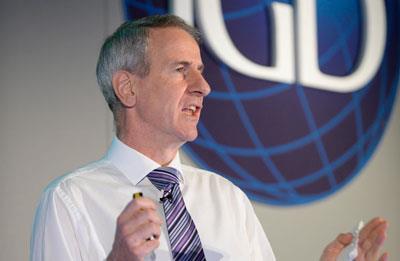
Grocery retailers under growing pressure from online and discount rivals are looking to cut billions of pounds in costs from their supply chains in the coming years, and logistics contractors will have to play their part in making these savings, the annual IGD supply chain summit in London heard this week.
The scale of savings the supermarkets are looking to make means that they cannot be achieved just by squeezing rates by tougher tendering – instead genuine collaboration between 3PLs, supplier and retailers will be needed to drive out inefficiency.
Huw Waters, supply chain director of Proctor & Gamble, pictured above, said that logistics now represented 30% of the total cost of food sold in supermarkets – the highest proportion for many years . Tesco, still the UK’s biggest grocer but under severe pressure to improve profitability, is focusing on cutting costs rather than increasing sales to restore margins.
“Logistics assets are under-utilised,” Waters said. “In the future we will have to inter-connect all the assets we have out there. We are sharing trucks and trailers – the future is a physical internet.”
Asda vice president, supply chain and ecommerce Gavin Chappell, pictured below, said that changes in shopper habits meant the fresh food supply chain “had to move back six hours”.

“It used to be ‘full by 9am’ but in many of our stores the busiest time is now 5am when they are picking home delivery orders,” Chappell said. “So I now need the stores ready by 3am – that will be a big initiative for Asda next year.”
As well as 283 superstores that do home deliveries, Asda currently has three ‘dark’ stores designed only for picking home delivery orders and is building more. Chappell said in future these would be “hybrid” stores that also included customer facilities such as fish counters: “They will offer a retail experience but with the efficiency of a warehouse shed.”
Chappell said another focus for Asda in 2015 would be addressing the worsening performance of its suppliers’ inbound deliveries. “Our inbound service has got worse this year, despite lower volumes,” he said. “We have to get the basics right on inbound.”














